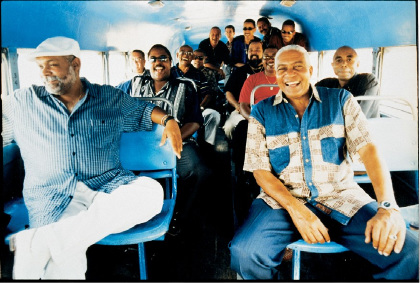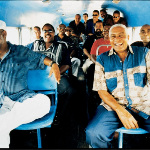- country:Cuba
- label:Lusafrica
- artist posted by:Planete Aurora
World Music - Charanga
Since its creation in 1939, Orquesta Aragon has maintained the original spirit of its earlier days, playing a delightful mix of cha cha cha, boleros, rumbas and danzones.The mythical band is still well alive, and it is a great pleasure to dance and share the music of this Charanga
HISTORY
For over forty years, Cubans have made Monday lunchtime their regular listening slot with the Orquesta Aragon on Radio Progreso broadcast, "Alegrias de la Sobremesa" (tableside variety show), during which humorous sketches and musical numbers played live on the set take turns. Whatever happens if it's Monday, then the airwaves from the island's westernmost point Cap San Antonio, to Punta Maisi in the east vibrate to the sound of the Aragon violins. The Aragon is one of those things that has been there forever as far as the Cubans are concerned. The group got today's grandparents dancing to the danzon, today's parents to the cha-cha, their children to the cha-onda.
The Orquesta Aragon's extraordinary adventure started on 30 September 1939, when double bass player Orestes Aragon Cantero brought his small charanga to Cienfuegos, the third largest town on the island, for their debut. The formation comprised violins, piano, flute, percussion and a singer. Charangas were specialized in the danzon, a style that was then about fifty years old; with its sung variant, the danzonete, it was quite the rage at the time. The group, which called itself Ritmica del 39, then Ritmica Aragon before settling on its final name of Orquesta Aragon at the end of 1940, also played waltzes and fashionable Spanish tunes. The band was no doubt just one of a number that played at dances and parties, but its founder's personality was to make all the difference. He held advanced social ideas (he was active in the popular socialist party, with communist allegiances), so he declared war on stardom. Performance fees were to be shared out evenly between all the musicians; it was out of the question that the lion's share would go to the director, or a star singer. "I want to found a musical family", he said. "I'm not looking for virtuoso players but musicians with human qualities."
Aragon was to conduct the band that bore his name for nine years, until a serious lung infection forced him into early retirement in 1948. Aragon appointed violinist Rafael Lay, who was only 20 years old but had already played for seven of them in the band, to take up the baton. On Lay's instigation, Orquesta Aragon gave its first concerts at La Havana, which to provincial musicians had always been held up as an impenetrable fortress. In 1953, when the vogue for cha-cha swept out the mambo, the Aragon seized its chance. It clinched a recording contract with American label RCA Victor, that was very active in Cuba, and in no time had a string of successes.
In 1954, flautist Richard Eguees brought his stunning virtuosity and unequalled sense of improvisation to the band. Hits such as El Bodeguero (the grocer, composed by Eguees, that Nat King Cole was to adopt), and Pare Cochero were to catapult the band way over the island's coastlines. Orquesta Aragon meant cha-cha, and the world over people danced to the rhythm of the band from Cienfuegos. In that ten-year period wide-eyed and joyful with the progress of science as sputniks and flying saucers crisscrossed the skies, the Aragon sang "I'm going to the moon for my honeymoon", and treated Cuba to its first demonstration (home-made) of stereophonic reproduction. Audiences were invited to tune into their radios and televisions simultaneously, and heard the sound of Eguees' flute or Lay's violin pass from one speaker to the other.
There was a succession of trips: Panama, Venezuela, United States right up to 1959 and the triumph of the Revolution. Imbibed with its founder's left-wing ideals, the band placed itself at the service of the new regime. All Cuba's musicians became State employees and were awarded the same salary, which boiled down to extending to the whole of the profession the co-operative principle instituted in the past by Orestes Aragon. Henceforth the Aragon served the people, to get them to dance but also instruct them, introduce them to their musical heritage. The band traveled the length and breadth of the country, which had just tasted agrarian reform and one of the largest ever literacy campaigns ever undertaken, to play in sugar cane production complexes, villages, factories, schools and hospitals.
The revolution knew how it could turn music to its advantage to spread its message. It was fast to form the habit of sending musicians abroad to act as ambassadors for Cuba's culture and new values. In 1965, the grand Cuban Music Hall tour brought the Aragon to France for the first time, where the musicians were mobbed throughout their three-week residence at the Paris' Olympia.
In November 1971, the Aragon discovered Africa, long after Africa had discovered the Aragon. The countries of Black Africa had lived through the end of colonialism and accession to independence to the accompaniment of the cha-cha. The Cuban models had far-reaching influence on modern African forms, starting with the Congolese rumba. To Africans ears, the Aragon was "the" standard by which Cuban music was judged and almost everywhere it went, the band was given a welcome befitting a head of state.
Africa in return left its mark on the group's music, with numbers such as Muanga, by Franklin Boukaka from the Congo, and later Yaye Boy, a hit from the Senegalese band Africando. The cha-onda, a rhythm and dance created by cellist Tomas Valdes at the beginning of the Seventies, owes a lot to a trip to Guinea and associating with the country's best band the Bembeya Jazz National.
In the Eighties the Aragon went through a difficult patch. Rafael Lay was killed in a car crash in 1982, Richard Eguees moved on from the band in 1984, and the musicians who had been there at the band's founding (timbales player Orestes Varona) or played during its golden age, followed each other into retirement. With Rafael Lay Junior in his father's shoes, the rejuvenated Orquesta Aragon, knocked sideways for a time by the dizzy evolution of Cuban dance music in the Nineties, decided to return to its roots. For its 1997 European tour and its album "Quien sabe sabe", the band took a joyful dive into its golden age repertoire and the period arrangements.
"La Charanga Eterna", in 1999, marks the sixtieth anniversary of the band's founding. This album is a happy medium between the rereading of the Aragon heritage (El Paso de Encarnacion, La Reina Isabel), the Cuban classics (Siboney, Bruca Manigua), and today's music, with Que Camello. A few guests came to join in on the celebrations: the great singer Omara Portuondo, the Puerto Rican friend Cheo Feliciano, the salsa legend, Papa Wemba from the Congo. Not forgetting singer Felo Bacallao, who was part of the Aragon line-up from 1959 to 1990, with his voice so much part of the Aragon's history still intact, who came back from Venezuela where he has settled.
The Orquesta Aragon has stayed true to the spirit of its founder, rather than to a musical style. The amateur dreamt of a family motivated by the love of music rather than the desire for making money. Orestes Aragon's dream has been a reality for sixty years. The work of making us love Cuba, its music and its people is not over.
Francois-Xavier Gomez



